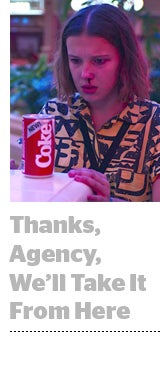Coke, Chevrolet, Casio, Burger King, Reebok, Adidas, Old Navy.
Netflix content including “Stranger Things,” “GLOW,” “El Camino” and the animated Christmas film “Klaus” are increasingly fertile ground for in-show product placements and brand tie-ins. Originals serve as the inspiration for new consumer products.
But most of those deals are struck directly between Netflix and the brands themselves.
Agencies feel sidelined in their dealings with the streaming platform, which multiple agency executives tell AdExchanger prefers to own the brand relationship.
Netflix says that although it does mainly works directly with brands, this isn’t a stated policy. Netflix told AdExchanger that it’s fluid and will partner via agencies when it makes sense and depending on the situation.
We’ll take it from here
But Ad Land begs to differ.
“You’re unlikely to find anyone on the agency side who’s involved in one of these deals, because that’s not how Netflix likes to work,” said Noah Mallin, a managing partner and head of content and experience at WPP agency Wavemaker, who has met with the team at Netflix in charge of brand tie-ins.
Although an agency might be asked to connect one of its brand clients with Netflix, either by request of the brand or because Netflix is looking for an intro to a brand that’s already organically written into one of its scripts – as was the case with the revival of New Coke in the third season of “Stranger Things” – that’s about it.
“We might connect the brand, but then you have to step back,” Mallin said. “They made it very clear that once a connection is made, they take over the conversation and that they may or may not reach back out.”
Another executive at a large holding company-owned media agency, who asked to remain anonymous, experienced much the same.
Netflix’s attitude was apparent in the follow-up messages the executive received from the platform after brokering an intro, “which goes something like, ‘We’re in touch with the brand now. This is our preferred way of working, thanks, we’ll contact them directly.’”
The other guys are open
But not every streaming service operates this way. Disney Plus, Hulu and AT&T are more than open to including agencies in their product placement and brand partnership discussions.
It’s only fair to point out, though, that Netflix is “coming at this from a completely different perspective,” Mallin said.
“Netflix has never had to play in an agency world, but for Disney, and certainly for Hulu and AT&T, this is both very familiar to them and a great opportunity to make up some of the dollars they’re losing in more traditional TV-oriented places,” he said.
Netflix is different in another way: As an ad-free service, it doesn’t have the leverage to nudge advertisers into upping their media spend. When a network notices that there’s a brand in one of its shows, it has the power to tell that brand to spend more on media or risk the product placement getting cut.
But the rise of OTT streaming content in general is an opportunity and a “brand new canvas” for creating noninterruptive brand experiences, which could be anything from brand integrations to original IP, said Eric Levin, EVP and global head of content at Publicis agency Spark Foundry.
“There’s an appetite for those things across the board,” Levin said.
On top of that, there are still opportunities for agencies to set up brand tie-in deals for clients by working around Netflix and going straight to the producer, set designer, writer or even the star of a show. If there’s a quid pro quo that makes sense– like a free location to shoot in exchange for an organic product placement – the deal gets done, and the show could easily end up on Netflix, either by being bought or licensed.
All about the originals
But it’s not third-party content that Netflix is so protective over – it’s the originals. Netflix CEO Reed Hastings intimated as much on a call with investors in July. Hastings noted that when it comes to product placements, brand tie-ins and merchandise, the core focus is to create “energy” that encourages more people to sign up for Netflix subscriptions.
It’s important to note that Netflix doesn’t necessarily make money when it works with a brand. Product placement within a show is almost always for creative storytelling purposes when brands are organically written into a script, and no money changes hands. Those arrangements are distinct from brand partnerships and consumer products, like the Baskin-Robbins/”Stranger Things” Scoops Ahoy pop-up parlor or Klaus-themed Old Navy merchandise.
In other words, brand tie-ins aren’t and probably won’t ever be a big driver of revenue for Netflix, and even if product placements were paid, it wouldn’t be significant to the bottom line.
In total, brand placements in “Stranger Things” season three, for example, had an estimated value of around $15 million, according to Concave Brand Tracking … which, even if that money was collected, wouldn’t amount to a drop in the bucket for a company that expects to add $5 billion in incremental subscription revenue this year.
Rather, these deals serve a higher purpose at Netflix – helping increase membership growth through fandom and word of mouth – which perhaps explains why Netflix is so controlling over the process and the relationships.
“Their revenue base is still very much about subscriptions,” Mallin said. “Revenue wise, at least, any work they do with brands is just a blip.”














